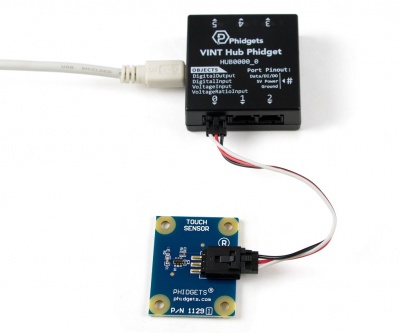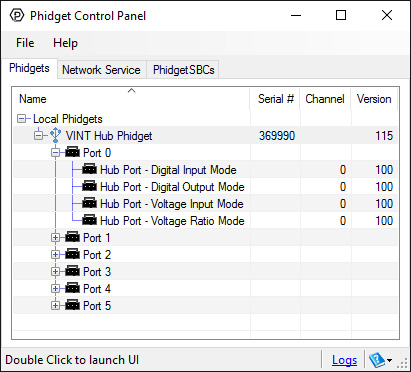1129 User Guide
Getting Started
Welcome to the 1129 user guide! In order to get started, make sure you have the following hardware on hand:
- 1129 - Touch Sensor
- Any Phidget with a Voltage Ratio Input port, here are some compatible products. We will be using the VINT Hub for this guide.
- USB cable and computer
- Phidget cable
Next, you will need to connect the pieces:

- Connect the 1129 to the HUB0000 with the Phidget cable.
- Connect the HUB0000 to your computer with the USB cable.
Now that you have everything together, let's start using the 1129!
Using the 1129
Phidget Control Panel
In order to demonstrate the functionality of the 1129, we will connect it to the HUB0000, and then run an example using the Phidget Control Panel on a Windows machine.
The Phidget Control Panel is available for use on both macOS and Windows machines. If you would like to follow along, first take a look at the getting started guide for your operating system:
Linux users can follow the getting started with Linux guide and continue reading here for more information about the 1129.
First Look
After plugging in the 1129 into the HUB0000, and the HUB0000 into your computer, open the Phidget Control Panel. You will see something like this:

The Phidget Control Panel will list all connected Phidgets and associated objects, as well as the following information:
- Serial number: allows you to differentiate between similar Phidgets.
- Channel: allows you to differentiate between similar objects on a Phidget.
- Version number: corresponds to the firmware version your Phidget is running. If your Phidget is listed in red, your firmware is out of date. Update the firmware by double-clicking the entry.
The Phidget Control Panel can also be used to test your device. Double-clicking on an object will open an example.
Voltage Ratio Input
Double-click on a Voltage Ratio Input object in order to run the example:

General information about the selected object will be displayed at the top of the window. You can also experiment with the following functionality:
- Modify the change trigger and/or data interval value by dragging the sliders. For more information on these settings, see the data interval/change trigger page.
- Select the 1129 from the Sensor Type drop-down menu. The example will now convert the voltage into a 1 (touch detected) or 0 (touch not detected) automatically. Converting the voltage to a 1 (touch detected) or 0 (touch not detected) is not specific to this example, it is handled by the Phidget libraries, with functions you have access to when you begin developing!
Technical Details
The 1129 is actually a capacitive change sensor. When the capacitance changes the Sensor Value reports 1. If the Sensor Value remains at 1 for longer than 60 seconds, it will recalibrate back down to 0, regardless if the sensor is still being touched. This recalibration can also be done manually by unplugging and plugging the sensor back into the HUB0000 (or compatible product). This is a useful feature because it means that the sensor can be mounted on a flat surface such as a piece of glass or plastic and be reset so that it does not register the change in capacitance caused by the surface it is mounted on. On the bottom side of the 1129 there is a small exposed metallic pad. A soldered connection can be made to the pad to increase the size and dimensions of the touchable area, such as attaching the sensor to a metallic object or some wire. Once the sensor is recalibrated, the Sensor Value will increase to 1 if the attached object is touched anywhere. Although there is an exposed metallic pad on the bottom of the board, the pad does not have to be touched directly to activate the sensor - touching anywhere on the board will activate the sensor. The 1129 can work as a close proximity sensor, sensing objects at a distance of up to 1/2" from the board in all directions without direct contact. The 1129 will also work through a thickness of up to 1/2" of glass, plastic, or paper.
Phidget Cable

The Phidget Cable is a 3-pin, 0.100 inch pitch locking connector. Pictured here is a plug with the connections labelled. The connectors are commonly available - refer to the Analog Input Primer for manufacturer part numbers.
The capacitor labelled C1 is the sensing capacitor. In other words this is the capacitor that determines how sensitive the sensor is. By default it is a 10nF capacitor. By changing this value we can adjust the sensitivity. Smaller capacitors will yield lower sensitivity while higher values will yield higher sensitivity. The integrated circuit (IC) on the 1129 specifies that the acceptable range for C1 is 2nF-50nF. In testing, 2nF will not sense through any thickness of material while 50nF can sense through over 1" of material and even through double paned windows with an air gap of up to 3/4". If the size of your capacitive touch surface is very large, you may have to increase C1 even more. Up to 100nF even. (C1 is soldered onto the board, in order to replace it you will need a soldering iron).
The DST1200 will fire saturation error events when the nearest reflection is closer than 40mm from the sensor. At this range it is too close for the sensor to accurately determine the range of the object.
If this happens, it could be due to interference on the power supply. If you're using the 1129 on a Wireless VINT Hub, laptop, or PhidgetSBC, try switching out the power supply to see if the problem persists.
What to do Next
- Programming Languages - Find your preferred programming language here and learn how to write your own code with Phidgets!
- Phidget Programming Basics - Once you have set up Phidgets to work with your programming environment, we recommend you read our page on to learn the fundamentals of programming with Phidgets.
